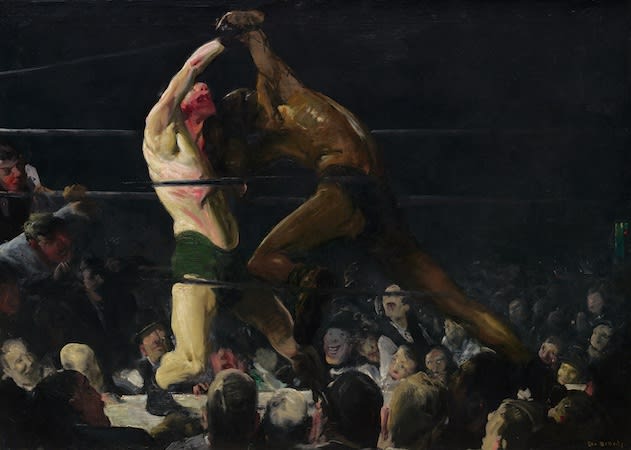George Bellows was not only one of America’s greatest painters and printmakers but also a chronicler of the social changes occurring in New York in the early twentieth century. Encouraged to draw the world around him by Ashcan painter and teacher, Robert Henri, Bellows painted urban landscapes which were often beautiful and, just as often, attacked by art critics for showing the darker side of urban life.
George Bellows at Fight Night
George Bellows’ New York studio was across the street from Sharkey’s Saloon, which held “Fight Nights” for amateur boxers. New York had a state ban on public boxing, so private clubs, like Sharkey’s, organized boxing matches in order to get around the ban. Black boxers were not allowed to join private clubs, but were permitted to fight in them.
A fine athlete himself, Bellows declined an offer to play professional baseball after high school and, instead, chose a career in art. He was drawn to the action at Sharkey’s and his paintings and lithographs of boxing matches chronicle the intensity and brutality of the fights.
The History of the Great White Hope
The story behind the Great White Hope had a strong impact on Bellows, who was a political activist and advocate of individual rights. Although black and white boxers often met in the boxing ring, it was not permitted, in the early twentieth century, for a black boxer to claim the title of world heavyweight champion.
Jack Johnson, an African American, was one of the greatest boxers of all time, and determined to become world heavyweight champion. The reigning world heavyweight champion of the time, James J. Jeffries, chose to retire rather than risk losing the title to Johnson.
Johnson spent two years challenging world heavyweight champion Tommy Burns for the title. Burns finally agreed to fight Johnson. The match was held in Sydney, Australia in 1908. Jack Johnson won the title, although the fight was stopped by the police after fourteen rounds because Burns was so badly beaten that police feared a white riot.
It was American writer Jack London who publicly goaded the former champion, Jim Jeffries, to become the great white hope and take the title back from a black fighter. “Jim Jeffries,” London wrote, “must now emerge from his alfalfa farm and remove that golden smile from Jack Johnson’s face. Jeff, it’s up to you. The White Man must be rescued.” Jeffries came out of retirement in 1910, saying that he would, “reclaim the heavyweight championship for the white race.”
On July 4, 1910, in Reno, the Fight of the Century took place. It lasted just fifteen rounds, with Jeffries throwing in the towel rather than having to endure the humiliation of a knockout.
George Bellows’ Point of View
The power of his work, combined with the irony of their titles, reflect both Bellows’ talent and point of view. Great White Hope, Both Members of This Club and his other works are evidence of Bellows’ ability to chronicle the world around him from the viewpoint of a socially conscience artist.
George Bellows Prints at Surovek Gallery
Please visit or contact us for more information about Great White Hope or other works by George Bellows in our gallery.

